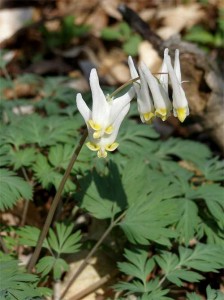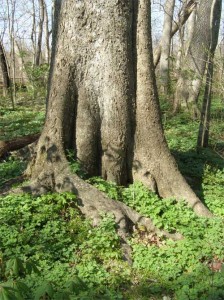You have to see it to believe it!

Flowers of seldom-seen Dutchman’s breeches seem to be hung out to dry. Photo by Ken Moore
By Ken Moore
Dutchman’s breeches – now there’s a truly descriptive common name. Most plant names, both the common ones and the official two-part (binomial) Latin names, are descriptive. In this case, the common name is “in your face†descriptive of a Dutchman’s wide flaring pantaloons, but you have to see it to believe it. If you practice “belly botany†to get a “closer look†at those flowers, you may be inclined to call them flying breeches, because they seem to be flying on a miniature clothesline close to the ground.
The official botanical name, Dicentra cucullaria, is a bit obscure. Dicentra, originally from the Greek “dis†(two) and “centrum†(spur), describes the two spurs of the base of the flower; cucullaria is from “cucullaris†(hood-like.) You really do have to see it!
As the warm temperatures have encouraged honey bees and other pollinators flying about, I’m now curious to see what kind of pollinators are struggling to get inside those breeches for pollen or nectar. I have a short window of time to catch them, because like trout lilies, which are now in peak bloom along Bolin Creek and the Botanical Garden trails, Dutchman’s breeches make a fleeting one- to two-week appearance before trees fully leaf out in mid-April.
More common in the mountains, Dutchman’s breeches are rare in our area. Last March, I joined a group of nature walkers guided by geologist/naturalist Pete Schubert to view a spectacular carpet of Dutchman’s breeches in northern Durham.
Pete’s description of the site provides insight into its rare presence:
“One of the showiest expanses of Dutchman’s breeches in the region can be found at the bend in the Flat River in Durham. Here, the south flowing river meanders sharply to flow west, then north, then east, then back south again in a large open ‘S’ in its floodplain.
As with the nearby Eno River at Penny’s Bend and further downstream along the Eno at Willie Duke’s Bluff, the Flat River is underlain by resistant diabase, an unusual bedrock that not only controls the course of the river but contributes a unique chemistry to the overlying soils. Calcium- and magnesium-rich minerals in the diabase weather to provide these nutrients in abundance in the soils – unique in the piedmont. The uplands of Penny’s Bend, the slopes of Willie Duke’s Bluff, and the river levee forest in the Flat River bend all host plants that are calcophiles – calcium-loving – and are typically found in the sweeter soils of the Midwest. Along with Dutchman’s breeches at the Flat River is a large expanse of the rare Isopyrum biternatum, false rue anemone, with its showy little white flowers similar to our rue anemone, or windflower, Thalictrum thalictroides.â€
I’m going to follow Pete again for this once-a-year event. You’re welcome to come along. He will lead an Eno River Spring Wildflower hike to the Bend in the Flat River this Sunday. Botanist Milo Pyne will lead a hike to the Willie Duke’s Bluff site along the Eno River the following Sunday, March 22.
Google “Eno River spring wildflower hikes†for hike descriptions and meeting times and places.
Given the vagaries of our recent weather, we may, or may not, catch the Dutchman’s breeches at their peak on these hikes – adding to the drama and suspense of springtime in the Piedmont. Regardless, you will see wildflowers!

Giant hackberry in the Flat River flood plain rises from a carpet of Dutchman’s breeches foliage, which is spectacular if you catch it at peak bloom. Photo by Ken Moore


Comments are closed.